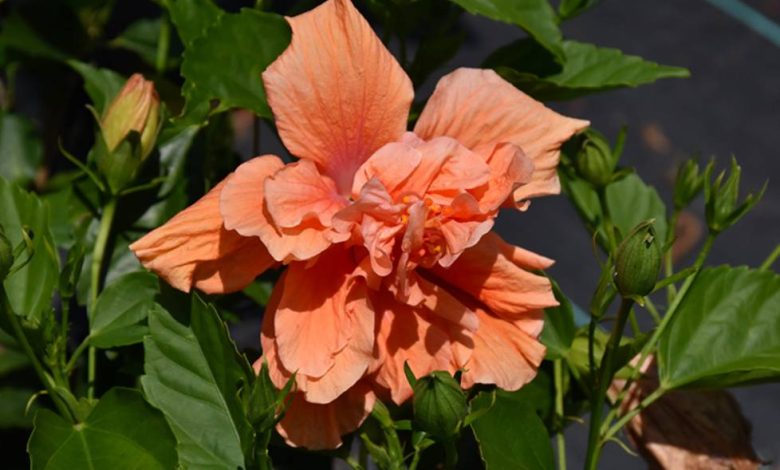Exploring the Peach Hibiscus Plant

The peach hibiscus, a member of the Hibiscus rosa-sinensis family, is a stunning flowering plant that has captured the hearts of gardeners and landscape enthusiasts alike. Known for its vibrant colors and unique characteristics, this tropical beauty enhances the visual appeal of gardens while attracting pollinators. In this article, we will explore the origins, features, cultivation, care, and various uses of this remarkable plant.
Origins of the Peach Hibiscus
The hibiscus family has its roots in tropical and subtropical regions around the globe. The specific variety known for its peach-colored blooms is believed to have originated in Asia, particularly in countries like China and India. Over time, it has been hybridized to produce numerous cultivars, each showcasing a distinctive array of colors and forms. The warm, soft hues of peach hibiscus, ranging from pale yellow to rich orange, evoke the blush of ripe fruit, making it a favorite among gardeners.
This plant has a rich cultural significance, especially in Hawaiian traditions, where its flowers symbolize beauty and femininity, often being used in traditional leis. Its vibrant blossoms hold a special place in ornamental gardening, symbolizing love and passion.
Characteristics of the Plant
The peach hibiscus is characterized by its large, eye-catching blooms and glossy green leaves. Flowers can reach up to six inches in diameter, featuring a prominent central column of stamens that enhances their allure. The petals often have a ruffled texture, creating a captivating visual effect. The foliage consists of dark green, lobed leaves that provide a lush backdrop for the flowers.
As a perennial shrub, this plant can grow between three to ten feet tall, depending on the conditions it’s grown in. It flourishes in warm climates and is sensitive to frost, making it ideal for USDA hardiness zones 9 to 11. Its bushy growth habit allows it to function well as a hedge or a standalone feature in a garden setting.
Cultivation
Ideal Growing Conditions
For optimal growth, this plant prefers full sun exposure, ideally receiving at least six hours of direct sunlight each day. It thrives in well-draining soil enriched with organic matter, with sandy or loamy soils being particularly suitable. The ideal pH level is between 6.0 and 6.8.
Watering is crucial, especially during the growing season. This plant prefers consistently moist soil but should not be waterlogged, as this can lead to root rot. Establishing a regular watering schedule and using mulch to retain moisture will promote healthy growth.
Propagation Methods
Propagation can be achieved through several methods, including seeds, cuttings, and layering. Seed propagation involves collecting seeds from mature plants and sowing them in a suitable medium. While this method is effective, it can be time-consuming, as seeds may take weeks to germinate.
Cuttings offer a quicker option. To propagate via this method, select healthy stems with several leaves, cut them at an angle, and place them in a moist potting mix. Covering the cuttings with a plastic bag can help maintain humidity until roots develop.
Layering is another effective technique where a low branch is bent to the ground and partially buried, allowing it to develop roots while still attached to the parent plant.
Care
Fertilization
Regular fertilization is essential for promoting vigorous growth and abundant blooms. A balanced fertilizer with an NPK ratio of 10-10-10 works well. Fertilizing every four to six weeks during the growing season will ensure that the plant receives the necessary nutrients. Organic fertilizers like compost can also enhance soil fertility and plant health.
Pruning
Pruning is vital for maintaining the shape and health of the shrub. Regularly removing dead or damaged branches encourages new growth and improves airflow. Ideally, pruning should be done in early spring before new growth begins, allowing the plant ample time to recover and produce flowers throughout the season.
Pest and Disease Management
While generally hardy, the plant can be susceptible to pests like aphids, spider mites, and whiteflies. Regular inspections and treatments with insecticidal soap or neem oil can help control these issues.
Diseases such as root rot and powdery mildew can occur, particularly in poorly draining soil or humid conditions. Ensuring proper watering practices and providing adequate airflow can minimize these risks. If diseases do develop, prompt removal of affected parts and fungicidal treatments can restore health.
Uses
The peach hibiscus serves various purposes beyond its ornamental value.
Ornamental Value
With its striking flowers and lush foliage, this plant is a popular choice in landscaping. It can be used in flower beds, as a focal point in garden designs, or planted in containers for patios and balconies. Its ability to bloom throughout the summer adds vibrant color to outdoor spaces.
Attracting Pollinators
One of the notable benefits of this plant is its ability to attract pollinators. Bees, butterflies, and hummingbirds are drawn to its large, nectar-rich blooms, playing a crucial role in pollination. Incorporating this plant into gardens helps create a pollinator-friendly environment, contributing to biodiversity.
Culinary and Medicinal Uses
In addition to its aesthetic appeal, the flowers are edible and can be used in herbal teas, salads, or as garnishes for various dishes. Hibiscus tea, known for its tart flavor and vibrant color, is enjoyed worldwide.
Medicinally, hibiscus has been used for centuries due to its potential health benefits. Rich in antioxidants, it may help lower blood pressure, improve digestion, and support heart health. However, it’s important to consult a healthcare professional before using it for medicinal purposes.
Conclusion
The peach hibiscus is a remarkable addition to any garden, offering beauty, ecological benefits, and practical uses. Its vibrant blooms and lush foliage can transform outdoor spaces, while its ability to attract pollinators enhances local ecosystems. With proper care, this plant can thrive, providing joy and color throughout the growing season. Whether you’re an experienced gardener or a novice, this tropical beauty is a worthy choice that will undoubtedly make a statement in your landscape.
